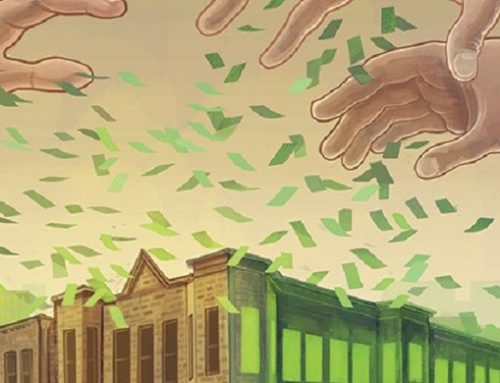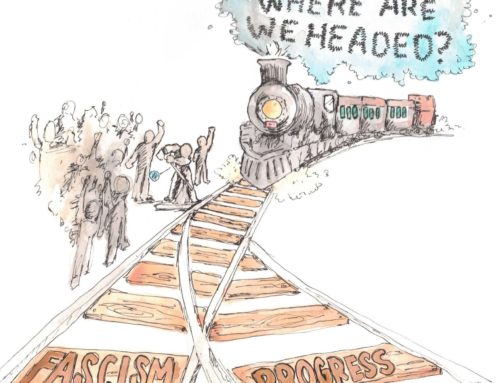By One Struggle — Rapid Response Network Committee
Photos by Sarah Cruz and Marty Goodman

(Names have been changed to protect the identities of union organizers).
The garment industry is a global web of nightmares, where suppliers compete to offer their products at the lowest possible cost to stores like Walmart, The Gap and J.C. Penney. This means starvation wages and unsafe conditions for the people working in sweatshops, the people who stitch, press and fold the t-shirts, pants and dresses that wind up on the shelves of US stores.
In October 2012, several members of One Struggle met in Port-au-Prince, Haiti with about 40 members of SOTA (Union of Textile and Apparel Workers) and SOKOWA (Union of Workers at CODEVI Free Trade Zone in Ouanaminthe)—autonomous trade unions organized through Batay Ouvriye (Worker’s Struggle).
Many of them produce clothing for familiar brands including Cherokee and Hanes. Haitian garment workers receive the industry’s lowest wages in the hemisphere: 200 gourdes, or less than $5 per day. According to a 2008 Worker Rights Consortium study, a family of one working member and two dependents needed at least 550 Haitian gourdes, or $12.50, per day to meet normal living expenses.
What follows is a glimpse into the garment assembly industry, its expansion in Haiti through imperialist domination, and so-called “development” hinged on exploitation.
Caracol Industrial Park, a 600-acre facility on the northern coast, reflects President Martelly’s slogan, “Haiti is open for business.” Brokered by the Clinton Foundation, developed by the Haitian government, the U.S. State Department, and the Inter-American Development Bank, the project brings 40,000 jobs and foreign investors to take advantage of Haiti while claiming to build its economy. Anchor tenant Sae-A, a Korean manufacturer, produces garments for Walmart and other companies. Sae-A’s new home sits atop fertile farmland, from which over 300 farmers were evicted.
Nadine, from SOTA, told us, “We would like to know how you can help to face imperialism. They came to do like the slave owners did before 1804.”
Garment assembly is tied to export-based economic development, pushed onto Duvalier in the 1980s by main sources of loans, then and now: U.S. Agency for International Development (AID), the World Bank, and the Inter-American Development Bank. With Haiti’s “comparative advantages”—cheap labor, hard-working people, proximity to the U.S., and year round growing season—USAID focused development on agribusiness and assembly industries. Monocrops and exports replaced subsistence and local production, forcing rural Haitians into urban slums, to buy rice imported from the US.
In theory, assembly industries absorb displaced farmers, providing jobs to them and existing urban unemployed. But Max, a member of SOTA, describes the reality. “When we get our wages, we need to be able to send our kids to school, pay rent, eat, healthcare. We don’t have these. The wages they give us have no value.”
Haiti’s export-based economy is bound to cheap labor, with the lowest wages in the western hemisphere. Foreign companies pay no taxes. Protective tariffs do not exist. Additionally, the U.S. lifted tariffs on goods shipped from Haiti to U.S. through 2020 (HOPE II and HELP Acts). According to secret State Department cables exposed by Wikileaks, the US Embassy and USAID worked with contractors for Fruit of the Loom, Hanes and Levi Strauss to keep wages low. In this climate, foreign investors profit, while no revenue is created for social programs like healthcare or education.
On October 1st, Parliament raised the minimum wage from 200 to 300 gourdes (about $7.25 a day). Manufacturers vehemently oppose this, and are responding by making the lives and conditions of workers even more miserable.
Annaise said that when the minimum wage was raised, the owner of her factory raised the hourly production quotas to levels impossible to fulfill. When workers refused, he fired many of them. “We need your help to ask for those people to go back to work. They cannot take a lot of time. All those people they fired, we must ask them to get those people back to work.”
Henrick, who works at One World factory, concurred. “When the minimum wage law passed, all the quotas went higher. The whole factory decided that morning not to work. When they called Baker [the factory owner], he said he will fire everybody. Is that a reality, or is it an injustice?”
The unjust reality is that raw material—purchased elsewhere and brought into Haiti duty-free—is made into clothing by Haitian laborers. Workers are paid much less than the value they add to raw goods, leaving more profit for manufacturers and factory owners. Clothing is shipped, tariff-free, to North America and sold at an enormous profit. Manufacturers resist wage increases to protect their rate of profit.
Batay Ouvriye helps factory workers organize to resist the manufacturers. SOTA is based in Port-au-Prince, in the south. SOKOWA is in Ounaminthe, the northeast, in the CODEVI Free Trade Zone. SOKOWA achieved workers’ rights to unionize and for collective bargaining, health rights, and protection against unemployment.
Destine, a member of SOKOWA, told us, “We have a trade union inside the factory that has nine years of existence. We faced a lot of repression from the Dominican soldiers, but we had international support. We spent about six to eight months fighting. In our struggle, the conditions improved.”
Caracol Industrial Park, CODEVI’s new neighbor, threatens SOKOWA’s gains by creating thousands of jobs at lower wages and with no bargaining agreements. In Guatemala, Sae-A’s previous manufacturing headquarters, the AFL-CIO reported company bribes, death threats, and imprisonment against union organizers. During a labor-management meeting, a Sae-A executive said, “It should be made clear that [in the face of opposition] the board of directors would simply go to work in another country, and the real losers would be the workers.” Sae-A closed their Guatemala factory, and moved to Nicaragua and Haiti.
Gille was fired for organizing (and winning) a struggle inside a garment factory to raise the wages from 36 to 250 gourdes a day. He stated, “I am an ex-worker in the trade union. When they fired me, they gave me time to organize. You, all the workers that are here today, we must count on our own strength. My brothers and sisters, here in Haiti, [and] the workers in the United States, we must have an international working class that fights to crush that exploitative system. That’s the solution to all the problems we are facing.”
Imperialist exploitation must be confronted by an international effort, led by autonomous organizations of workers. If Sae-A workers in Caracol producing Walmart garments band together with Bangladeshi workers also producing for Walmart, and with Walmart warehouse workers in Illinois, then it would be possible to ignite a movement that could win.







I don’t even know how I ended up here, but I thought this
post was great. I do not know who you are but certainly you’re going
to a famous blogger if you aren’t already 😉 Cheers!
[…] let alone provide a material alternative to it. Indeed, until garment workers in countries like Haiti and Bangladesh, who are involved in producing the commodities sold in retail stores, are able to […]
[…] let alone provide a material alternative to it. Indeed, until garment workers in countries like Haiti and Bangladesh, who are involved in producing the commodities sold in retail stores, are able to […]